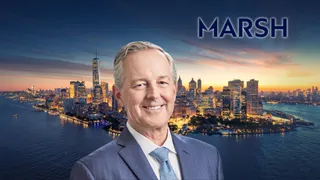
Risk universe expanding but reinsurers need to remain relevant
The universe of risks is expanding, which represents a big opportunity for reinsurers—but there are also challenges they must address, including their very relevance to clients as the portion of risks they cover continues to shrink.
That was an overarching theme that emerged from the annual Guy Carpenter Symposium, called “Partnering through crises, shocks and cycles,” which took place in the Kongresshaus in Baden-Baden on October 20.
The session included a keynote presentation by Laurent Rousseau, chief executive officer of EMEA & Global Capital Solutions, Guy Carpenter; and Giambattista ‘GB’ Taglioni, partner, Oliver Wyman. It was followed by a panel discussion featuring Roland Oppermann, member of the board, SV SparkassenVersicherung; Andreas Berger, group CEO, Swiss Re; and Maria Rapin, CEO, Nephila Climate.
“Shocks and crises are what we do—it is the raw material of our business,” Rousseau said in his opening remarks. He went on to say that the best way for the industry to meet these challenges was through true partnerships.
“A true partnership is hard; it is an overused term,” he said. “In reality, things are more transactional. A true partnership is a choice you make, one you have to keep making.” He said the panel discussion would offer three perspectives on this in the context of the industry: from an insurer, a reinsurer and an investor.
Rousseau discussed the reinsurance cycle, noting the steady capital growth in the industry in recent years. He suggested reinsurance could reach $620 billion in 2024, up from $436 billion in 2018. He highlighted some of the challenges reinsurers have faced through this period—struggling for profitability in some periods. “In that sense, it is clear that partnerships have worked,” he said.
He flagged the fact that, especially in recent years since retention levels were increased some two years ago, primary insurers are bearing the brunt of losses far more and the share of global cat losses absorbed by reinsurers has been falling.
“It leads to the question of how we add value,” he said. “We need to beware of becoming irrelevant.”
He flagged some other notable trends in the industry. The insurance-linked securities (ILS) market continues to grow steadily, with the 144A cat bond market now worth some $45 billion. He also noted that better data and technology are driving rapid growth in parametric products, suggesting this segment could be worth $30 billion by 2030, up from around $12 billion now.
He said the industry must remain open to innovation but be aware of its competitors, and also what he called “contenders”, waiting in the sidelines with disruptive solutions.
“The share of global cat losses absorbed by reinsurers has been falling.”
Responding to change
Taglioni at Oliver Wyman offered a similar perspective. He stressed how quickly the nature of risk is changing. “Reinsurers should not rest on their laurels. They should react and innovate to change if they are to remain relevant,” he said.
“The reality is that risks are changing, the world is becoming more volatile,” he said. He highlighted the protection gap in several areas, including in extreme weather, where only some 30 percent of losses are insured, and in cyber, where the protection gap is vast. He highlighted risks that present “unknown unknowns” for the industry, such as artificial intelligence.
“The industry is resilient—but what is the level of ambition when it comes to really meeting the expectations of society?” Taglioni asked. “We believe the solution is in partnerships. No one individual can find a solution to global events or tackle them. In a fast-changing world, our speed of innovation needs to be faster. But for that to happen, we need to work together.”
He posed the question as to whether the industry should partner more with the public sector. He noted that there are many good examples of such schemes around the world.
“Some risks such as cyber are simply too big for the private industry to cover alone. But what is the right framework to insure those risks in the proper way? That said, I think we will get there. I am personally extremely optimistic on the future of the industry,” he said.
Rousseau agreed that such partnerships must be explored. “The question is where do we come in as risk-takers? Where there are systemic risks, you need to start considering the role of the public sector,” he said.
He finished by making the distinction between price and value. “As technical reinsurers it is natural to focus on price, but this misses the bigger picture of what value reinsurers can add. People are ready to step up,” he concluded.
For more news from Baden-Baden Today, click here.
Did you get value from this story? Sign up to our free daily newsletters and get stories like this sent straight to your inbox.
Editor's picks
Editor's picks
More articles
Copyright © intelligentinsurer.com 2024 | Headless Content Management with Blaze

